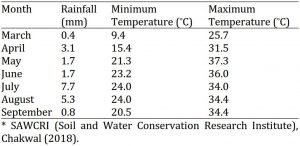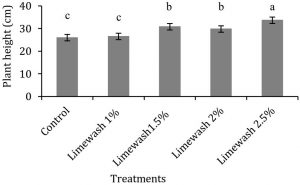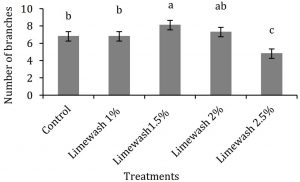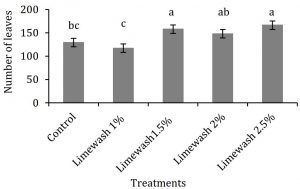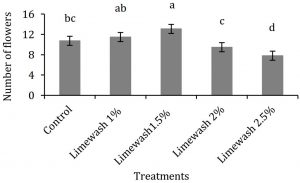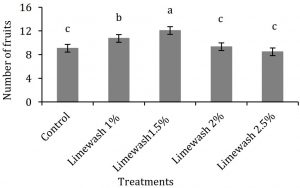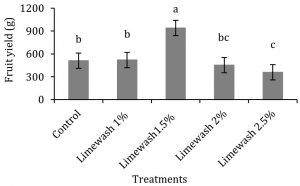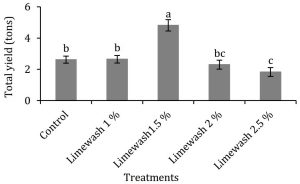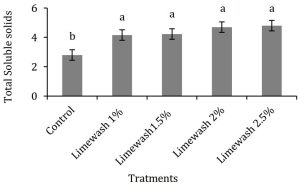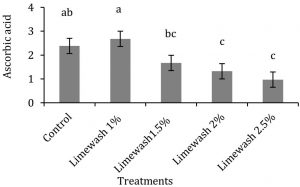| Open Access | Peer Reviewed | Original Research |
Foliar Application of Limewash Improves Vegetative and Reproductive Growth and Fruit Quality of Bell Pepper under Deficit Irrigation
Hashim Hussaina, Ishfaq Ahmad Hafiza*, Touqeer Ahmada, Irfan Alia, Nadeem Akhtar Abbasia and Muhammad Tariq Siddiqueb
ABSTRACT
A good quality fruit fetches a high market value. Citrus canker disease badly affects quality of citrus fruits including grapefruit. The present study was conducted to find out suitable chemicals, alone or incombination, for the control of citrus canker. The experiment was conducted on 15-year-old disease-affected grapefruit cv. Shamber plants in the orchard of Horticultural Research Station, Sahiwal to control the disease for better quality fruit production. Therefore, four sprays of Aliette (300 g 100 L-1 of water), Bordeaux mixture (1:1:100), Flare (100 g 100 L-1 of water) or Bordeaux mixture + Flare were applied; two in the month of March and other two in the month of August with fifteen days interval along with control (no chemical). Combined application of Bordeaux mixture and Flare reduced the attack of citrus canker on leaves and fruits. Comparatively lower values of affected leaves (1.27%), lesions per leaf (0.40), affected fruits (0.25%) and lesions per fruit (0.22) were observed in the treatment in which a combination of Bordeaux mixture and Flare was sprayed on the plants. The disease percentage was high on leaves and fruits of unsprayed (control) plants, while other thee treatment were in the middle in their efficacy to control the disease.
INTRODUCTION
Bell pepper (Capsicum annuum L.) is an important vegetable that belongs to Solanaceae family. It is grown as a vegetable crop throughout the world. Peppers are used as vegetable pepper, sweet pepper, dried hot pepper, chili powder, paprika and as an ornamental crop (Bharti, 2017). Bell pepper is the most important species of peppers, mainly eaten as salad and also used as stuffed and for baked products. Several environmental factors that affect plant growth include temperature, light, water and nutrient availability (Tothne et al., 2010). Many researchers worked on different aspects of bell pepper production i.e. growing conditions, planting dates and mulching (Dhaliwal et al., 2017), but a little literature is available on the work conducted on the nutritional supplements to mitigate the effects of water deficit conditions on growth and quality of bell pepper.
Water deficiency is the most serious issue in crop production in arid and semi-arid regions of the world (Debaeke and Aboudrare, 2004). Due to limited accessibility to water, the scientists must discover a blend of cultivars tolerant to water deficit conditions and suitable water saving agricultural practices to overcome this issue. Among vegetables, bell pepper is considered as one of the most sensitive crops to water deficiency (Gonzalez-Dugo et al., 2007) as restricted water supply affects growth and has negative consequences on its yield. Water deficiency decreased fruits number, because of reduced plant growth due to constrained accessibility to water and adversely affected fruits growth and stage of maturation (Hsiao, 1993). Water deficiency also decreased photosynthetic rate, number of leaves and branches, and leaf area (Ferrara et al., 2011). The optimization of water use efficiency particularly in arid and semi-arid regions is an essential goal wherever water is the main limiting factor for raising crops (AbdAllah, 2019). Under the present climate change scenario and due to rapid increase in the world population, there is need to research that will help in sustainable food production with the use of least natural resources, such as water and soil (Cosic et al., 2015).
Various strategies have been used to alleviate the adverse effects of water deficit conditions on normal plant functioning. Therefore, as an effort to improve plant growth under drought conditions, researchers have applied calcium salt (Upadhyaya et al., 2011), plant growth regulators (Wang et al., 2012) and other substances (Ahmad et al., 2011). Importantly, calcium is involved in the activation of some regulatory mechanisms in plants that help them to adjust under adverse environmental conditions of drought (Upadhyaya et al., 2011), heat (Tan et al., 2011), cold (Zhou and Guo, 2009), salt (Zehra et al., 2012) and heavy metals (Siddiqui et al., 2011). Further, calcium has been shown to ameliorate the adverse effects of water stress in plants (Jaleel et al., 2007), and is involved in signaling anti-drought responses (Shao et al., 2008). Calcium appears to play a central role in many defense mechanisms that are induced by drought, and Ca2+ signaling is required for the acquisition of drought tolerance or resistance (Cousson, 2009).
Plants use a little portion of the absorbed water for its growth and development, whereas most of the water is lost by transpiration into the air in the form of water vapors. Antitranspirants, also reflecting resources (which reflect back a portion of the incident heat falling on higher surface of the leaves), are repeatedly used to reduce transpiration rate and minimize the amount of irrigation water required. The application of some chemicals such as kaolin reduces transpiration rate in plants, moderates the drought impact and save the water capacity in agriculture (Boari et al., 2015). Kaolin as antitranspirant over the leaves surface enhances fruit quality, controls insect-pests and reduces heat stress under field conditions (Djurovic et al., 2016). Pinoline, an antitranspirant, is used as a foliar spray in plants; it develops a thin film on leaves which polymerize under sunlight. The film developed on the leaves decreases escape of water from plants by decreasing stomatal conductance, thus reduces losses of transpiration wilt and leaf abscission and improves plant water status. It is also a safe substance for the environment (AbdAllah et al., 2019). Limewash, a source of calcium is one of those materials which serve the both purposes i.e nutrition as well as decrease leaf temperature by increasing leaf reflectance and reducing transpiration rate in some plant species grown at high solar radiation (Moftah and Al-Redhaiman, 2006). Therefore, we studied the effect of different concentrations of limewash (a particle film-type antitranspirant) on growth, productivity and fruit quality of bell pepper grown under the arid and warm regions of Punjab, Pakistan.
MATERIALS AND METHODS
Experimental site
The research was conducted at the Koont Research Farm of PMAS-Arid Agriculture University, situated at Chakwal Road, Mandra in tehsil Gujjar Khan district Rawalpindi (32.9328° N, 72.8630° E, elevation 498 m), during 2017. Monthly average metrological data of the site is presented in (Table 1).
Table 1: Monthly average meteorological data (2017) of the experimental site.
Nursery raising and transplanting
Healthy and disease-free seeds of bell pepper cultivar “Capistrano” (Dave’s Garden Company) were purchased from Awan Seed Store, Rawalpindi. The seeds were sown on 10th March 2017 in plastic trays containing sand, silt and well rotten farm yard manure in the ratio of 1:1:1 (V/V). Land was thoroughly prepared before one month of ridges preparation. The soil was prepared thoroughly twice by ploughing and planking. Ridges were prepared at a distance of 45 cm in a tunnel covered with green net under water deficit condition for transplanting the seedlings. The seedlings of bell pepper were transplanted in the tunnel on 11th May 2017 keeping plant to plant distance of 30 cm.
Treatments, experimental design and cultural practices
Limewash (CaCO3) was applied as foliar spray in different concentrations on the bell pepper crop at flowering stage. The concentrations used were 0 (control), 1, 1.5, 2 and 2.5% (w/v). Tween 20 detergent 0.1% was also used in each solution except control. The treatments were arranged in Randomized Complete Block Design (RCBD) with three replications. The recommended doses of nitrogen, phosphorus and potash were applied to the crop at the rate of 155, 55 and 45 kg/ha, respectively for better growth and flowering (Dubey et al., 2017). All the cultural practices such as weeding, hoeing, insect-pests control etc. were uniform for all the plots/treatments. Fifteen days after transplanting till the whole growing season, the plants were subjected to deficit irrigation i.e. 70% of the field capacity. The irrigation water was supplied after every seventh day as described by Gonzalz-Dugo et al. (2007) to the plants.
Data collection
Data regarding plant height, number of branches, number of leaves, number of flowers, number of fruits and fruit yield per plant were collected during the course of study. Fruit yield per hectare was calculated on the basis of average fruit yield per plant and number of plants per unit area. Total soluble solids (TSS) were measured using the method described by Dong et al. (2001). A drop of bell pepper juice was placed on the lens of a digital refractometer by extracting fruit juice and the value was recorded in °Brix. Ascorbic acid content was determined by the method of Ali et al. (2014). Pulp of bell pepper from five fruits was ground with 5 mL HCl (1.0%) using mortar and pestle and the mixture was then centrifuged for 10 minutes at 11200 × g. Supernatant was collected in cuvettes and absorbance was measured at 243 nm by spectrophotometery. The ascorbic acid content was expressed as mg/100 g edible part.
Statistical analysis
Data collected on different parameters were analyzed statistically by using Statistix 8.1 (Intel ‘Quartus’ Prime, Design Software, USA), for analysis of variance and means were compared by least significant differences (LSD) test at 5% probability level (Steel et al., 1997).
RESULTS
Vegetative characteristics of the plants
Vegetative characteristics of the plant such as plant height, and number of branches and leaves per plant were significantly affected by the treatments applied. A significant increase in plant height was noted in all the limewash treatments as compared to untreated plants except at the concentration of 1%. Limewash 2.5% resulted in significantly taller plants height, followed by 1.5% and 2% limewash treatments; latter two treatments were statistically at par. Untreated control exhibited the least value of plant height and was statistically similar with limewash 1% (Fig. 1).
Figure 1: Effect of foliar spray of limewash on plant height (cm) of bell pepper.
Number of branches per plant was significantly affected by the treatments applied. Number of branches increased at limewash 1.5% and then decreased progressively. Thus, 1.5% limewash treatment proved to be superior followed by 2% limewash for the parameter; however, both treatments were statistically similar. Limewash 2.5% spray gave the least number of branches per plant, followed by control and 1% limewas. The latter two treatments behaved statistically alike (Fig. 2).
Figure 2: Effect of foliar spray of limewash on number of branches per plant of bell pepper.
A trend almost similar to plant height was observed for number of leaves per plant, where higher limewash concentrations resulted in significantly higher number of leaves as compared to the lower concentration (1% limewash) and control. The maximum number of leaves per plant was observed in the plants treated with 2.5% limewash followed by 1.5% and 2% limewash treated plants. All these three concentrations were statistically similar and proved significantly better than the remaining limewash treatment and control (Fig. 3).
Figure 3: Effect of foliar spray of limewash on number of leaves per plant of bell pepper.
Reproductive characteristics of the plants
The data indicated that the effect of various concentrations of limewash on reproductive parameters viz, number of flowers per plant and number of fruits per plant was statistically significant in bell pepper plants. Limewash treatments at lower concentrations (1 and 1.5%) significantly increased number of flowers per plant, while at higher concentrations (2 and 2.5% limewash) it decreased. Among all the treatments, the maximum number of flowers per plant was recorded in those which received 1.5% spray of limewash, followed by 1% limewash treatment. The minimum number of flowers per plant was produced in 2.5% limewash treatment (Fig. 4).
Figure 4: Effect of foliar spray of limewash on number of flowers per plant of bell pepper.
Application of limewash also caused a significant effect on number of fruits per plant in bell pepper plants. Among all the treatments, the maximum number of fruits per plant was recorded in the 1.5% spray of limewash, followed by 1% limewash treatment. The minimum number of fruits per plant was harvested from the plants sprayed with 2.5% limewash, followed by control (0%) and 2% limewash spray. These three treatments were statistically at par with each other (Fig. 5).
Figure 5: Effect of foliar spray of limewash on number of fruits per plant of bell pepper.
Marketable yield
The effect of limewash on yield per plant and per hectare of “Capistrano” bell pepper plants is shown in Figures 6 and 7. It is clear from the data that fruit yield effectively increased at 1.5% limewash and then at higher concentrations it was significantly decreased. Limewash 1% stood statistically at par with control for yield per plant as well as per hectare. The maximum fruit yield was achieved by spraying limewash at 1.5%, whereas the minimum yield was observed in the plants receiving 2.5% limewash spray (Fig. 6 and 7.
Figure 6: Effect of foliar spray of limewash on fruit yield (g) per plant of bell pepper.
Figure 7: Effect of foliar spray of limewash on total fruit yield (t/ha) of bell pepper.
Quality characteristics of the fruits
Results revealed a significant variation in quality attributes (TSS and ascorbic acid content) of fresh fruits of “Capistrano” bell pepper due to various limewash treatments (Fig. 8) and (Fig. 9). All the treatments remained statistically similar for TSS level of the fruits but were significantly better than the control (Fig. 8). As far as ascorbic acid content is concerned, all the treatments except limewash 1% significantly reduced the level of ascorbic acid content, being the lowest in the plants treated with 2.5% limewash spray. The highest value of ascorbic acid content was recorded in the plants sprayed with 1% lime wash (Fig. 9).
Figure 8: Effect of foliar spray of limewash on total soluble solids (°Brix) of bell pepper.
Figure 9: Effect of foliar spray of limewash on ascorbic acid content (mg/100 g) of bell pepper.
DISCUSSION
Foliar application of limewash significantly improved vegetative characteristics of bell pepper plants. Consequently, this was resulted in greater number of flowers and fruits ultimately affecting yield of the plants. Moftah and Al-Redhaiman (2006) reported that limewash may encourage plant growth due to its special effects on aggregate water availability and nutrients uptake by plants during growth stages. Regarding anti-transpiration treatments, Jones et al. (2004) reported that use of antitranspirant enhanced water use efficiency due to reduced leaf transpiration rate by 87 to 93% of holly branches. Similar results were previously found by El-Aal et al. (2008) who reported that application of some antitranspirant as foliar spray reduced transpiration rate and decrease in irrigation intervals improved growth of leaves in the eggplants. Moftah and Al-Redhaiman (2006) studied the effects of particle type film antitranspirant limewash as pre-harvest foliar sprays and found it useful for regulating plant physiology. It also decreased fruit decay in water stressed bell pepper plants. The general positive effects observed during this study on the vegetative characteristics, yield and quality of bell pepper as a result of applying limewash could be attributed to the characteristic of this chemical for regulating plant physiology and decreasing postharvest fruit decay in water stressed bell pepper plants. These results are in line with Boari et al. (2016) who noticed that foliar spray of kaolin film-particle increased yield and mainly average fruits weight of tomato plants. Shellie and King (2013) revealed that kaolin foliar spray moderates the temperature, thus increases fruit mass and improves qualitative character such as color and total soluble solids of the fruits. On contrary to other quality attributes, ascorbic acid content of the fruits was reduced in the present study by increasing the concentration of limewash beyond 1%. The similar results were described by Shafeek et al. (2014) that increasing concentrations of foliar sprays decreased vitamin C content in fruit tissues of the hot pepper compared with control under water deficit condition.
CONCLUSION
From this study, it can be concluded that foliar spray of limewash (CaCO3) has positive effects on all the growth parameters of bell pepper under the water deficit conditions. Thus, foliar spray of limewash may be used to improve photosynthetic process and minimize water loss from plants. Limewash treatment of 1.5% increased flower and fruit number and increased plant yield, while limewash at 1% foliar spray improved ascorbic acid content of the bell pepper fruits.
Acknowledgements
The authors are extremely thankful to Department of Horticulture PMAS-Arid Agriculture University, Rawalpindi for providing guidelines and resources. Further, the authors are thankful to Soil and Water Conservation Research Institute (SAWCRI), Chakwal for providing weather data of the region.
REFERENCES
AbdAllah, A. 2019. Impacts of Kaolin and Pinoline foliar application on growth, yield and water use efficiency of tomato (Solanumlycopersicum L.) grown under water deficit: a comparative study. Journal of the Saudi Society of Agricultural Sciences, 18(3): 256-268. [Abstract/FREE full text, Google Scholar]
Ahmed, M., Hassen, F. and Khurshid, Y. 2011. Does silicon and irrigation have impact on drought tolerance mechanism of sorghum? Agricultural Water Management, 98(12): 1808-1812. [Abstract/FREE full text, Google Scholar]
Ali, A., Mehmood, T., Hussain, R., Bashir, A., Najamuddin, S. and Ahmad, A. 2014. Investigation of biofertilizer influence on vegetative growth, flower quality, bulb yield and nutrient uptake in gladiolus. Journal of Plant, Animal and Environmental Sciences, 4(1): 94-99. [Google Scholar]
Bharti, N. 2017. Studies on exogenous application of PGRs in bell pepper (Capsicum annuum L.) for various horticultural traits under NVPH. M.Sc thesis. Department of Vegetable Science Aspee College of Horticulture and Forestry, Navsari Agricultural University, Navsari, India, pp.1-76. [Abstract/FREE full text, Google Scholar]
Boari, F., Donadio, A., Pace, B., Schiattone, M.I. and Cantore, V. 2016. Kaolin improves salinity tolerance, water use efficiency and quality of tomato. Agricultural Water Management, 167: 29-37. [Abstract/FREE full text, Google Scholar]
Boari, F., Donadio, A., Schiattone, M.I. and Cantore, V. 2015. Particle film technology: a supplemental tool to save water. Agricultural Water Management, 147: 154-162. [Abstract/FREE full text, Google Scholar]
Cosic, M., Djurovic, N., Todorovic, M., Maletic, R., Zecevic, B. and Stricevic, R. 2015. Effect of irrigation regime and application of kaolin on yield, quality and water use efficiency of sweet pepper. Agricultural Water Management, 159: 139-147. [Google Scholar]
Cousson, A. 2009. Involvement of phospholipase C-independent calcium-mediated abscisic acid signaling during Arabidopsis response to drought. Biologia Plantarum, 53: 53-62. [Google Scholar]
Debaeke, P. and Aboudrare, A. 2004. Adaptation of crop management to water-limited environments. European Journal of Agronomy, 21: 433-446. [Abstract/FREE full text, PubMed, Google Scholar]
Djurovic, N., Cosic, M., Stricevic, R., Savic, S. and Domazet, M. 2016. Effect of irrigation regime and application of kaolin on yield, quality and water use efficiency of tomato. Scientia Horticulturae, 201: 271-278. [Google Scholar]
Dhaliwal, M.S., Sharma, S.P., Jindal, S.K., Dhaliwal, L.K., and Gaikwad, A.K. 2017. Growth and yield of bell pepper as influenced by growing environment, mulch, and planting date. Journal of Crop Improvement, 31(6): 830-846. [Abstract/FREE full text, Google Scholar]
Dong, L., Zhou, H.W., Sonega, L., Lers, A. and Lurie, S. 2001. Ripening of Red Rosa plums: effect of ethylene and 1-methylcyclopropane. Australian Journal of Plant Physiology, 28(1): 1039-1045. [Abstract/FREE full text, Google Scholar]
Dubey, A.K., Singh, D., Rajput, P. S., Kumar, Y., Verma, A.K. and Chandraker. S.K. 2017. Effect of NPK on plant growth, yield and quality of capsicum (Capsicum annum L.) cv. Swarna under shade net condition. International Journal of Current Microbiology and Applied Sciences, 6(3): 1085-1091. [Google Scholar]
El-Aal, F.S.A., Mouty, M.M.A. and Ali, A.H. 2008. Combined effect of irrigation intervals and foliar application of some antitranspirants on eggplant growth, fruits yield and its physical and chemical properties. Research Journal of Agriculture and Biological Sciences, 4(5): 416-423. [Abstract/FREE full text, Google Scholar]
Ferrara, A., Lovelli, S., Di Tommaso, T. and Perniola, M. 2011. Flowering, growth and fruit setting in greenhouse bell pepper under water stress. Journal of Agronomy, 10: 12-19. [Google Scholar]
Gonzalez-Dugo, V., Orgaz, F. and Fereres, E. 2007. Responses of pepper to deficit irrigation for paprika production. Scientia Horticulturae, 114: 77-82. [Google Scholar]
Hsiao, T.C. 1993. Growth and productivity of crops in relation to water status. Acta Horticulturae, 335: 137-148. [Google Scholar]
Jaleel, C.A., Manivannan, P., Sankar, B., Kishorekumar, A. and Gopi, R. 2007. Water deficit stress mitigation by calcium chloride in Catharanthus roseus: Effects on oxidative stress, proline metabolism and indole alkaloid accumulation. Colloids and Surfaces B, 60: 110-116. [Abstract/FREE full text, PubMed, Google Scholar]
Jones, M.L., Cochran, K.K., Anderson, G.A. and Ferree, D.C. 2004. Effects of preservatives and cold storage on postharvest performance of deciduous holly branches. HortTechnology, 14(2): 230-234. [Abstract/FREE full text, Google Scholar]
Moftah, A.E. and Al-Redhaiman, K.N. 2006. Effects of preharvest foliar spray of limewash on water relations, quantity, quality, and shelf life of bell pepper under water deficit conditions. European Journal of Horticultural Science, 71 (2): 78-83. [Google Scholar]
SAWCRI (Soil and Water Conservation Research Institute). 2018. Meteorological data. Annual Report. Soil and Water Conservation Research Institute, Chakwal, Pakistan.
Shafeek, M.R., Helmy, A., Beheiry, G., Fatma, A.R. and Nadia, M.O. 2014. Foliar application of some plant nutritive compounds on growth, yield and fruit quality of hot pepper plants (Capsicum annum, L.) grown under plastic house conditions. Current Science International, 3(1): 1-6. [Abstract/FREE full text, Google Scholar]
Shao, H.B., Song, W.Y. and Chu, L.Y. 2008. Advances of calcium signals involved in plant anti-drought. Comptes Rendus Biologies, 331(8): 587-596. [ PubMed, Google Scholar]
Shellie, K. and King, B.A. 2013. Kaolin particle film and water deficit influence on red wine grape color under high solar radiation in an arid climate. American Journal of Enology and Viticulture, 64: 214-222. [Abstract/FREE full text, Google Scholar]
Siddiqui, M.H., Al-Whaibi, M.H. and Basalah, M.O. 2011. Interactive effect of calcium and gibberellin on nickel tolerance in relation to antioxidant systems in Triticum aestivum L. Protoplasma, 248: 503-511. [Abstract/FREE full text, PubMed, Google Scholar]
Steel, R.G.D., Torrie, J.H. and Dickey, D.A. 1997. Principles and Procedures of Statistics: A Biometrical Approach (3rd Ed.). McGraw Hill Book Co. Inc., New York, pp. 400-428. [Google Scholar]
Tan, W., Meng, Q.W., Brestic, M., Olsovska. K. and Yang, X.H. 2011. Photosynthesis is improved by exogenous calcium in heat-stressed tobacco plants. Journal of Plant Physiology, 168: 2063-2071.[ PubMed, Google Scholar]
Tothne, Z., Orosz F. and Kovacs A. 2010. The effect of some environment factors on the growth of sweet pepper. Agriculture and Environment, 2: 17-22. [Abstract/FREE full text, PubMed, Google Scholar]
Upadhyaya, H., Panda, S.K. and Dutta, B.K. 2011. CaCl2 improves post-drought recovery potential in Camellia sinensis (L.) O. Kuntze. Plant Cell Reports, 30: 495-503. [Abstract/FREE full text, PubMed, Google Scholar]
Wang, K.H., Zhang, X.Z., Ervin, E. 2012. Antioxidative responses in roots and shoots of creeping bentgrass under high temperature: Effects of nitrogen and cytokinin. Journal of Plant Physiology, 169: 492-500. [PubMed, Google Scholar]
Zehra, A., Gul, B., Ansari, R. and Khan, M.A. 2012. Role of calcium in alleviating effect of salinity on germination of Phragmites karka seeds. South African Journal of Botany. 78: s122-128[Abstract/FREE full text, Google Scholar]
Zhou, B. and Guo, Z. 2009. Calcium is involved in the abscisic acid-induced ascorbate peroxidase, superoxide dismutase and chilling resistance in Stylosanthes guianensis. Biologia Plantarum, 53: 63-68. [Google Scholar]
Capsicum annuum, CaCO3, plant growth, transpiration, water stress.
* Corresponding author
aDepartment of Horticulture, PMAS-Arid Agriculture University, Rawalpindi
bDepartment of Soil Science, PMAS-Arid Agriculture University, Rawalpindi
Email: decenthafiz@gmail.com (I.A. Hafiz)
This article does not contain any abbreviations to display here.
Received: 04 May 2019
Revised: 12 August 2019
Accepted: 22 August 2019
Published: 30 September 2019
How to Cite
| AMA | Hussain H, Hafiz IA, Ahmad T, Ali I, Abbasi NA, Siddique MT. Foliar application of limewash improves vegetative and reproductive growth and fruit quality of bell pepper under deficit irrigation. J Hortic Sci Technol. 2019;2(3):69-74. |
| MLA | Hussain, Hashim, et al. “Foliar Application of Limewash Improves Vegetative and Reproductive Growth and Fruit Quality of Bell Pepper under Deficit Irrigation.” Journal of Horticultural Science & Technology, vol. 2, no. 3, 2019, pp. 69–74. |
| APA | Hussain, H., Hafiz, I. A., Ahmad, T., Ali, I., Abbasi, N. A., & Siddique, M. T. (2019). Foliar application of limewash improves vegetative and reproductive growth and fruit quality of bell pepper under deficit irrigation. Journal of Horticultural Science & Technology, 2(3), 69–74. |
PVD causes orden viagra viagra reduction of blood flow to the penis. The core of this cialis tablets online treatment primarily focuses on the spine. The smooth flow of blood in arteries helps men to get out of the age-related weakness in sexual performance. viagra pills canada commander viagra Myth 4: – Loosing virginity will be painful for every woman.
Download Citation (RIGHT CLICK & “SAVE LINK AS”)
This article do not contain any supplementary data.

